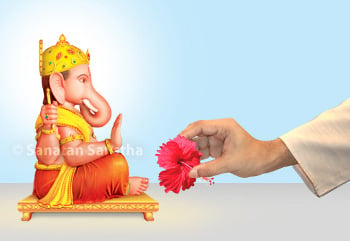
Offering red flower to Shri Ganapati
When flowers associated with a Deity are offered to that Deity, for example red flowers to Shri Ganapati, the benefit derived of the Principle of that Deity is greater.
Frequencies of the Principles
of Deities attracted to flowers, form of
frequencies transmitted into the atmosphere
and the colour of fragrant particles floating in the air
Flower |
Frequencies of the Deity Principle which get attracted |
Minimum number of flowers required to attract maximum frequencies |
Form of the frequencies transmitted into the atmosphere |
Colour of the fragrant particles floating in the air |
|---|---|---|---|---|
| 1. Mogra | Devi Durga | One or nine | Like small circles | Golden |
| 2. Nishigandha | Shiva | Zero or ten | Like a fountain | Silvery |
| 3. Kanher | Devi Mahakali | Nine (Note 1) | Like rays, with high speed | Reddish purple |
| 4. Tagar | Brahma | Six | Scattered, like rapidly moving particles | Yellowish white |
| 5. Swastik | Devi Saraswati | Nine (Note 1) | Like rapidly moving sparks from pin-wheel | Bluish |
| 6. Shevanti | Shri Mahalakshmi | Nine (Note 1) | Like a drizzle | Yellowish |
| 7. Kamal | Shri Lakshmi | Nine (Note 1) | Like a spring | Bright red |
| 8. Jhendu | Shri Lakshmi | Nine (Note 1) | Like a spray | Reddish |
| 9. Jai | Shriram | Four | Like a spray | Brilliant yellow |
| 10. Chameli | Deity Hanuman | Five | Like rays | Bright saffron |
| 11. Jui | Deity Datta | Seven | Like a fountain | Orange |
| 12. Krushnakamal | Shrikrushna | Three | Spiral | Dark blue |
Note 1 : Offer nine flowers to the energy forms of Devi Durga (Primalenergy). The number ‘9’ indicates the actual function in dvait (duality) of Devi Durga through Her other forms. Hence, it is appropriate to offernine flowers to Her forms – Devi Mahakali, Devi Saraswati, Devi Mahalakshmiand Devi Lakshmi.
‘Lahari’ of Principles of Deities attracted
to flowers and‘pavitrake’ transmitted from these flowers
The group of subtler vibrations of the principles of Deities attracted towards the flowers are known as ‘lahari’ (A group of subtler-waves of the Principles of Deities). These lahari transmitted from the flowers with a higher content of sagun (Materialised) Principle are known as ‘pavitrake’ [Subtle most particles containing Chaitanya (Divine consciousness)]. The pavitrake are grosser in nature than the lahari.
The absorption of lahari or pavitrake by an individual depends onthe bhav (Spiritual emotion) of the individual. Greater the sagun bhav in an individual, greater is the activation of lahari in the flower. These lahari further attain maximum sagun form, meaning, they attain pavitrake formand function directly at an individual level for that individual. For an individual with nirgun (Non-materialised) bhav, the lahari act directly at the subtle level. The difference between pavitrake and lahari of a Deity attracted in a particular substance is given in the following table.
|
Pavitrake of the Deity |
Frequencies of the Deity Principle |
|
|---|---|---|
| 1. Which is in greater proportion – sagun or nirgun? | Sagun | Nirgun |
|
2. Form of the Lahari |
Like high speed rays | Like waves |
|
3. Nature of the Lahari |
Restless | Peaceful |
| 4. Ability to purify | Deh | Deh and kosh |
| 5. Manifestation | Along with sagun | Along with nirgun |
Difference between Fragrant particles and pavitrake
Fragrant particles |
Pavitrake |
|
|---|---|---|
| 1. Level | More of sagun | Sagun |
|
2. Related Cosmic Principles
|
Pruthvitattva and Apatattva | Tejtattva and Vayutattva |
| 3. Function | Purification of the
environment around the worshipper |
To enhance the proportion of Sattva particles in the prana-deha of the worshipper |
| 4. Ability to actually perform a task | Less | More |
| 5. Duration of effectiveness | Less | More |
| 6. Ability to bestow spiritual experience | Less | More, of any type depending on the bhav of the worshipper |
Why should flower buds not be plucked after sunset ?
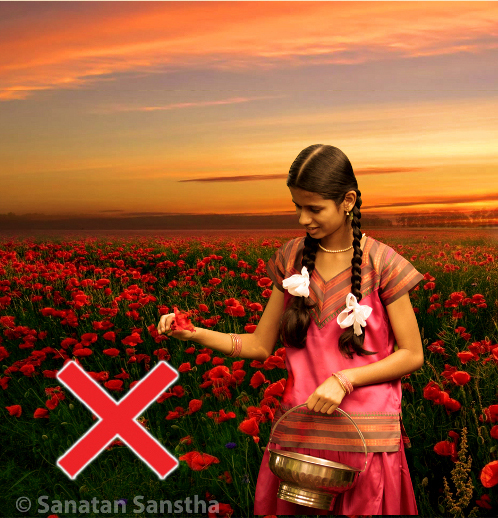
At Brahmamuhurt, that is between 4 and 6 a.m., the pavitraks of Deities descend to the earth in greater proportions. The pavitraks of Deities are attracted only to those flowers which have the potential to absorb them. The radiance of the Sun causes disintegration ofthe raja-tama particles in the atmosphere. Hence, the period before sunset is more sattvik than after it. After sunset the raja-tama predominance in the atmosphere increases. Consequently,the atmosphere gets polluted due to increased movement of negative energies. That is why, after sunset the flower buds get contaminated with raja-tama particles. This reduces their ability to attract pavitraks of Deities. For this reason the flower buds are usually not plucked after sunset.
Flowers like the mogra, Chameli (Jasmine), Nishigandha (Tuberose) etc. await eagerly to attract maximum pavitraks of Deities into them. The buds of the seflowers start blooming by sunset and eagerly await the Brahmamuhurt.It is because of their eagerness that the pavitraks of Deities are attracted to them to a greater extent. Hence, their fragrance is strong and soothing to the mind when compared to that of other flowers. Some flowers like the white and pink hibiscus bloom even after sunrise. These flowers attract hardly any or no pavitraks of Deities at all and have no fragrance.Offering such flowers to Deities is akin to offering paper flowers, hence a worshipper derives no benefit.
Flowers of plants like the Tulsi (Holy basil), Zendu (Marigold), Gulab (Rose), Kevada (Screwpine)etc. bloom a little everyday and remain fresh, on the plant for severaldays. These flowers have a mild fragrance and have greater potential to attract waves of the Guru Principle. Wherever the Guru Principleis active or present in sagun (Materialised) form the subtle fragrance of these flowers pervades even in the absence of gross flowers. So if one experiences the mixed subtle fragrances of the Tulsi, Gulab, Zendu or Kevadathen one can conclude that the Guru Principle has materialised at the site for our sake.
Why should dried or worm infested leaves, flowers
andfruits not be used in the ritualistic worship of God ?
1. Always offer the best to Deities. They subtly partake what is offered to them and then pleased with the offering, they bless the devotee.
2. The prana-vayu (One of the five vital energies) in the leaves, flowers and fruits is responsible for the absorption of Sattva waves and the specific Deity Principle from the Universe. The Dhananjay-vayu from these substances transmits these waves and the Principle. Fresh leaves, flowers and fruits have over 70% prana-vayu and dhananjay-vayu in them. For absorption of the sattvik waves, subtle waves and the principleof the Deity transmitted from the ritualistic worship, the percentage of prana-vayu and dhananjay-vayu should be atleast 50%. Freshleaves, flowers and fruits can absorb these waves and the Principle in greater quantity. Cosequently, the one performing ritualistic worship, those consuming the fruits and inhaling the scent of the flowers are able to derive maximum benefit of the Principle and the Sattva waves emitted by the Deity. Thus leaves, flowers and fruits are storehouses of the sattvikta and waves of the Principle. When these substances are affected by raja-tama components at the subtle level, they get spoilt at the gross level. Then the prana-vayu and dhananjay-vayu in them falls below 50% level. Consequently, their capacity to absorb the Sattva waves and waves of the Principle of the Deity is lowered. No one benefits from use of such substances.Deities partake the offerings subtly and are not pleased with such offerings and therefore do not bless the devotee.’
Why do lotus and avala remain pure for 3 days and
why should they be immersed in water thereafter ?
Lotus emits 40% Devi Lakshmi Principle and avala (Indian gooseberry) emits 30% BrahmaPrinciple. This emission requires prana-vayu and dhananjay-vayu. Lotus and avala have the ability to combat raja-tama for three days.The prana-vayu as well as dhananjay-vayu lasts in them to the extent of more than 50% for three days. That is why they can remain pure for three days. After three days the proportion of prana-vayuin them reduces to less than 50% and that of dhananjay-vayu to less than 30%. That is why they start to dry up. Still they retain the Deities Principle and Sattva waves upto 10%. Hence, they are beneficial even after three days. By immersing the dried lotus and avala in water the benefit from the remaining Deity Principle and Sattva waves from them reach many more individuals after merging with the water. (Through the medium of Ms. Madhura Bhosale,5th January 2005, 9.11 p.m.)

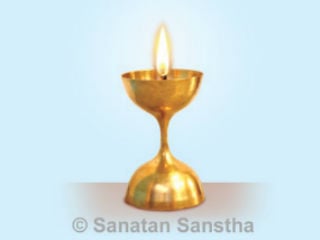 Waving a lit lamp symbolizes puja of Deity with Atmajyoti
Waving a lit lamp symbolizes puja of Deity with Atmajyoti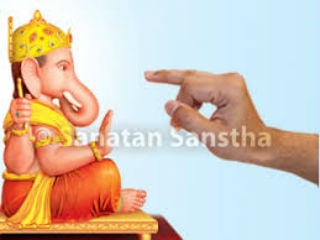 Benefits of applying gandha followed by offering of haldi and kumkum to Deities
Benefits of applying gandha followed by offering of haldi and kumkum to Deities Shodashopachar puja – Means of abiding Dharma in a ritualistic and bhav enriched manner
Shodashopachar puja – Means of abiding Dharma in a ritualistic and bhav enriched manner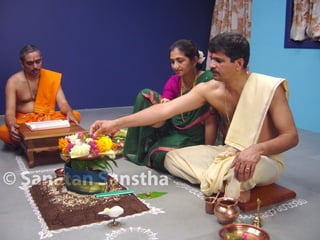 What are the benefits obtained from Puja preparations?
What are the benefits obtained from Puja preparations?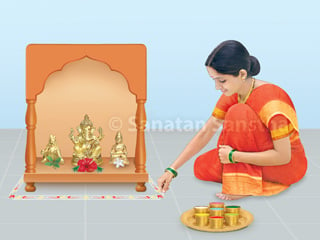 Importance of drawing Rangoli as a part of Puja preparations
Importance of drawing Rangoli as a part of Puja preparations Sounding of a conch at the commencement of a puja
Sounding of a conch at the commencement of a puja